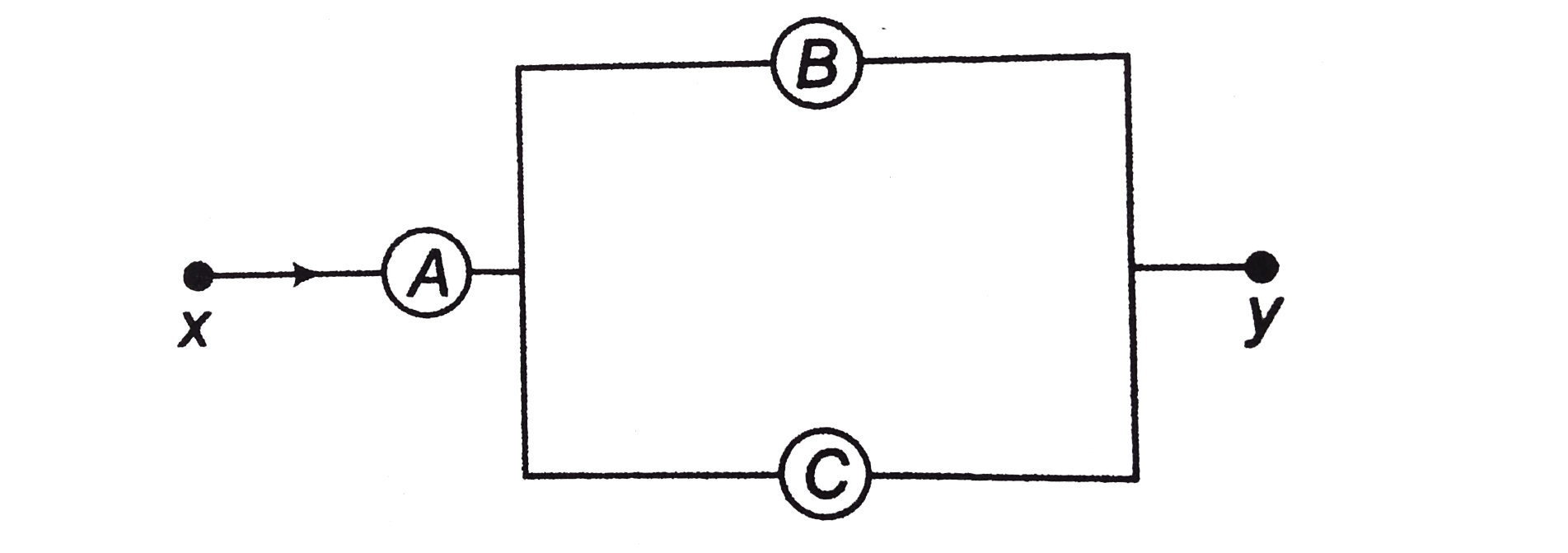Three voltmeters all having different resistance, are joined as shown. When some potential difference is applied acros A and B, their readings are V1,V2 and V3. Then

(i),(ii)
(ii),(iii)
(iii),(iv)
(i),(iv)
The correct Answer is:B
Step by step video, text & image solution for Three voltmeters all having different resistance, are joined as shown. When some potential difference is applied acros A and B, their readings are V_1,V_2 and V_3. Then by Physics experts to help you in doubts & scoring excellent marks in Class 12 exams.
Topper's Solved these Questions
Similar Questions
Three voltmeters A, B and C having resistances R, 1.5 R and 3 R respectively are used in a circuit as shown. When a potential difference is applied between X and Y, the readings of the voltmeters are V1,V2andV3respectively. Then :
 View Solution
View SolutionThree resistors R1=3kΩ,R2=2kΩandR3=5kΩ have been connected to a constant current source as shown in figure. The current source supplies current I=2mA to the circuit. A voltmeter with RV=6kΩ internal resistance is connected, as shown, to measure the potential difference across R1.
(a) Find the percentage error in the measurement of potential difference (V1) across. R1 caused due to finite resistance of the voltmeter.
(b) If positions of R2andR3 are interchanged will the percentage error in measurement of V1 increase or decrease ?
 View Solution
View Solution
Knowledge Check
- Question 1 - Select One or More
Three ammeters 1, 2, and 3 of resistances R1.R2andR3 respectively are joined as shown. When some potential difference is applied across the terminals P and Q, their readings are I1,I2andI3, respectively. Then
 AI1=I2BI1R1+I2R2=I3R3CI1I2=R3R1DI2I3=R3R1+R2
AI1=I2BI1R1+I2R2=I3R3CI1I2=R3R1DI2I3=R3R1+R2 - Question 2 - Select One
A,B and C are voltmeters of resistances R,1.5R and 3R respectively. When some potential difference is applied between x and y the voltmeter readings are VA,V_BandV_C, then
 AVA=VB=VCBVA≠VB=VCCVA=VB≡VCDVA+VB=VC
AVA=VB=VCBVA≠VB=VCCVA=VB≡VCDVA+VB=VC - Question 3 - Select One
A,B and C are voltmeters of resistance R, 1.5 R and 3R respectively as shown in the figure. When some potential difference is applied between X and Y, the voltmeter reading are VA,VBandVC respectively.
AVA=AB≠VCBVA≠VB≠VCCVA=AB=VCDVA≠VB=VC
Three voltmeters A, B and C having resistances R, 1.5 R and 3 R respectively are used in a circuit as shown. When a potential difference is applied between X and Y, the readings of the voltmeters are V1,V2andV3respectively. Then :
 View Solution
View SolutionWhen a potential difference (V) is applied across a conductor, the thermal speed of electrons is
View SolutionThree voltmeters are connected as shown.

A potential difference has been applied between A and B. On closing the swich S, readings of voltmeters?View SolutionA 2-A current flows through a resistor when a potential difference of 20 V is applied across it. The resistance of the resistor is
View SolutionIn the circuit shown, a potential difference of 60V is applied across AB. The potential difference between the point M and N is
 View Solution
View Solution
